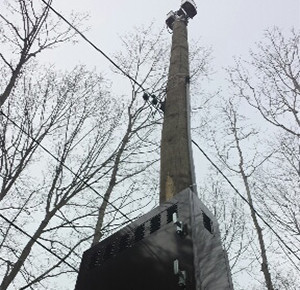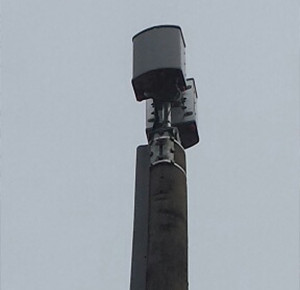Summary of Draft Ordinance
Requires all future antennas and wireless telecommunications facilities (WTF) to be subject to the ordinance.
Requires applicants to provide the following information to the Village:
Location of proposed antennas
Copy of the agreement between the applicant and the property
A site plan showing where the proposed antennas will be in relation to the property and other structures located thereon.
Elevations showing heights of all antennas.
A cash deposit or bond of 200% of the proposed cost of removing the antenna if it is abandoned.
Copies of all FCC approvals
Certification by a licensed professional engineer that all electromagnetic radiation emissions are within the FCC guidelines.
Created a preference of location for facilities in the following order:
Collocation with existing telecommunications facilities.
Collocation on properties located in commercial or industrial zoning districts
Properties located in commercial or industrial zoning districts
Properties located in other nonresidential zoning districts
Properties located in residential zoning districts
An applicant must disclose all sites that it is considering inside the Village and within 2 miles of the Village.
Applications must include:
The location of all residential structures within 750 feet of a tower and 250 feet of other wireless telecommunication facilities.
| The applicant must identify its utilization of the most recent technological design. In doing so submit a plan of the proposed project. |
| The applicant’s proposed WTF maintenance and inspection procedures and related system of records. |
| Certification, including such documentation as the Planning Board shall require, that NIER levels at the proposed site are within the threshold levels adopted by the FCC. |
| A certification that the construction and placement of the proposed freestanding tower and the proposed antenna(s) will not interfere with public safety communications, the usual and customary transmission or reception of radio, television, or other communications services enjoyed by adjacent residential and nonresidential properties, or other existing telecommunications devices. |
| A copy of the FCC license applicable for the use of the WTF. |
| Certification that a topographic and geomorphologic study and analysis has been conducted and, taking into account the subsurface and substrata and the proposed drainage plan, that the site is adequate to assure the stability of the proposed wireless telecommunications tower on the proposed site. |
| Propagation studies of the proposed site and all adjoining proposed or in-service or existing sites. |
The applicant shall disclose, in writing, any agreement in existence prior to submission of the application that would limit or preclude the ability of the applicant to share any WTF that it constructs.
All applications for the construction of a new WTF shall be accompanied by a WTF engineering report containing the information hereinafter set forth. The report shall be prepared, signed and sealed by professional engineer or registered architect licensed in the State of New York. Where this section calls for certification, such certification shall be by a qualified New York State licensed professional engineer acceptable to the Village. The application shall include, in addition to the other requirements for the SUP, the following information:
| (a) |
Documentation that demonstrates the need for the WTF to provide service primarily within the Village. |
| (b) |
The name, address, and telephone number of the person preparing the report. |
| (c) |
The name, address, and telephone number of the property owner, lessee, operator and applicant, including the legal basis for the applicant’s authority. |
| (d) |
The legal description, postal address, and tax map designation of the property. |
| (e) |
The zoning district in which the property is situated. |
| (f) |
The size of the property, stated both in square feet and lot line dimensions. |
| (g) |
A survey of the property indicating the dimensions of the property, the location and height of all structures, the location, size and height of all proposed and existing towers, antennas, and accessory structures, and the type, size and location of all proposed and existing landscaping and fencing. |
| (h) |
Indicate the location of all residential structures within seven hundred fifty (750) feet, in the case of a freestanding tower and within two hundred and fifty (250) feet in the case of all other WTF applications. |
| (j) |
The names, addresses, and telephone numbers of all owners of other freestanding towers or existing antenna support structures located within a one-half-mile radius of the proposed WTF including Village-owned property. The address and location of each such freestanding tower or antenna support structure shall be indicated. |
| (k) |
The number, type and design of the WTF’s proposed antenna(s) and the basis for the calculations of the WTF’s capacity to accommodate multiple users. |
| (l) |
The make, model and manufacturer of the WTF and antenna(s). |
| (m) |
A description of the proposed WTF and antenna(s) and all related fixtures, structures, appurtenances and apparatus, including height above preexisting grade, materials, color and lighting. |
| (n) |
The frequency, modulation and class of service of radio or other transmitting equipment. |
| (o) |
The transmission and maximum effective radiated power of the antenna(s). |
| (p) |
The direction of maximum lobes and associated radiation of the antenna(s). |
| (q) |
The applicant must identify its utilization of the most recent technological design. In doing so submit a plan of the proposed project. |
| (r) |
The applicant’s proposed WTF maintenance and inspection procedures and related system of records. |
| (s) |
Certification, including such documentation as the Planning Board shall require, that NIER levels at the proposed site are within the threshold levels adopted by the FCC. |
| (t) |
A certification that the construction and placement of the proposed freestanding tower and the proposed antenna(s) will not interfere with public safety communications, the usual and customary transmission or reception of radio, television, or other communications services enjoyed by adjacent residential and nonresidential properties, or other existing telecommunications devices. |
| (u) |
A copy of the FCC license applicable for the use of the WTF. |
| (v) |
Certification that a topographic and geomorphologic study and analysis has been conducted and, taking into account the subsurface and substrata and the proposed drainage plan, that the site is adequate to assure the stability of the proposed wireless telecommunications tower on the proposed site. |
| (w) |
Propagation studies of the proposed site and all adjoining proposed or in-service or existing sites. |
| (x) |
The applicant shall disclose, in writing, any agreement in existence prior to submission of the application that would limit or preclude the ability of the applicant to share any WTF that it constructs. |
| (y) |
Certification that the WTF, foundation and attachments are designed and will be constructed to meet all local, county, state and federal structural requirements for loads, including wind and ice loads. If the WTF is subsequently approved and constructed, similar “as-built” certification indicating that the WTF has been constructed in accordance with all standards shall be furnished prior to the Village issuance of a SUP. |
|
|
| (z) |
An affidavit attesting to the fact that the applicant made diligent, but unsuccessful, efforts to install or collocate the applicant’s WTF on freestanding towers or antenna support structure owned by other persons located within a one-half-mile radius of the proposed WTF. |
| (aa) |
Certification that the proposed site of the WTF does not pose a risk of explosion, fire, or other danger to life or property due to its proximity to volatile, flammable, explosive, or hazardous materials such as LP gas, propane, gasoline, natural gas, or corrosive or other dangerous chemicals. |
|
The applicant shall present an evaluation of at least three alternative sites comparing the characteristics of each with the requirements of the proposed WTF and demonstrating why the alternate sites would be incompatible for collocation. Reasons supporting incompatibility could include, but not be limited to the following:
| (a) |
Existing structures and/or towers are not of sufficient height to meet the applicant’s engineering requirements within the geographic service area described. |
| (b) |
Existing structures and/or towers do not have sufficient structural strength to support the applicant’s antennas and equipment. |
| (c) |
The applicant’s proposed antenna or antennas would cause electromagnetic interference with the antenna or antennas of the existing WTFs. |
| (d) |
The cost or contractual provisions required by the owner of an existing WTF site, or to adapt an existing WTF site for sharing, would exceed the cost of erecting a new site. |
|
|
Visual Assessment Impact shall include:
| (1) |
A “zone of visibility” map which shall be provided in order to determine locations where the WTF may be seen. |
| (2) |
Pictorial representations of “before” and “after” views from key viewpoints both inside and outside of the Village to be determined by the Planning Board, including, but not limited to, major roads, county and local parks, other public lands, historic districts, preserves and historic sites normally open to the public, and from any other location where the WTF is visible to a large number of visitors, travelers, or residents. The Village will provide guidance concerning the appropriate key views in evaluating the site. |
| (3) |
An assessment of the visual impact of the WTF base and accessory structures from abutting and adjacent properties and streets. |
| (4) |
Color photo simulations showing the proposed site of the WTF with a photo-realistic representation of the proposed WTF as it would appear viewed from the closest residential property and from adjacent roadways.
To the extent practicable, a visual impact assessment must include simulations of the proposed WTF in all seasons, including “leaf-off” simulation in winter season.
Applicable to All Antennas:
No antenna shall be more than twenty (20) feet above the top of the structure upon which it is placed.
A freestanding WTF shall be the minimum height necessary in order to meet the service needs, but no higher than 100 feet.
The height of accessory structures shall not be higher than 12 feet.
Board Consultant
The Planning Board may hire its own consultant to evaluate the application. Applicant shall make an initial deposit of $5,000 and shall make replenishments when necessary.
Planning Board Decision Considerations:
Public health, safety and welfare related codes and requirements.
Traffics needs.
Historic Nature of neighborhood.
Placement of WTF which would create a risk to residents or the public.
Surrounding tree coverage and foliage.
Whether the proposed WTF will have an adverse visual impact or diminish property values.
Responsibility of Owners:
Must submit evidence of compliance with FCC standards to Village on a yearly basis.
All facilities shall be certified by an engineer to be structurally sound and resubmitted every 3 years.
Insurance:
Owner shall maintain liability insurance for personal injuries and property damage in the amount of $2,000,000 per occurrence, $3,000,000 aggregate.
Indemnification:
Applicant shall agree to indemnify and hold harmless the Village for any damages arising from the facility.
Miscellaneous:
In the case of any malfunction, the carrier shall discontinue use of the facility.
If the facility becomes unsafe, it shall be removed immediately.
If anyone erects or substantially modifies a facility without necessary permits, they shall can be punished by a fine of up to $5,000 or imprisonment of up to thirty (30) days.
|
|
|
|
|








